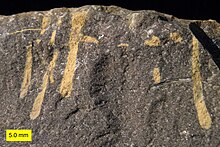Trypanites
Appearance


Trypanites is a narrow, cylindrical, unbranched boring which is one of the most common trace fossils in hard substrates such as rocks, carbonate hardgrounds and shells (Bromley, 1972). It appears first in the Lower Cambrian (James et al., 1977), was very prominent in the Ordovician Bioerosion Revolution (Wilson and Palmer, 2006), and is still commonly formed today. Trypanites is almost always found in calcareous substrates, most likely because the excavating organism used an acid or other chemical agent to dissolve the calcium carbonate (Taylor and Wilson, 2003). Trypanites is common in the Ordovician and Silurian hardgrounds of Baltica (Vinn et al. 2015).
References
- Bromley, R.G. (1972). "On some ichnotaxa in hard substrates, with a redefinition of Trypanites Mägdefrau". Paläontologische Zeitschrift. 46: 93–98. doi:10.1007/bf02989555.
- Cole, A.R., Palmer, T.J. (1999). "Middle Jurassic worm borings, and a new giant ichnospecies of Trypanites from the Bajocian/Dinantian unconformity, southern England". Proceedings of the Geologists' Association. 10 (3): 203–209. doi:10.1016/S0016-7878(99)80070-4.
{{cite journal}}: CS1 maint: multiple names: authors list (link) - James, N.P., Kobluk, D.R., Pemberton, S.G. (1977). "The oldest macroborers: Lower Cambrian of Labrador". Science. 197 (4307): 980–983. doi:10.1126/science.197.4307.980-a. PMID 17784131.
{{cite journal}}: CS1 maint: multiple names: authors list (link) - Taylor, P.D., Wilson. M.A. (2003). "Palaeoecology and evolution of marine hard substrate communities". Earth-Science Reviews. 62 (1–2): 1–103. doi:10.1016/S0012-8252(02)00131-9.
{{cite journal}}: CS1 maint: multiple names: authors list (link) - Vinn, O.; Wilson, M.A.; Toom, U. (2015). "Bioerosion of Inorganic Hard Substrates in the Ordovician of Estonia (Baltica)". PLOS ONE. 10(7): e0134279. doi:10.1371/journal.pone.0134279. Retrieved 2015-09-21.
{{cite journal}}: CS1 maint: unflagged free DOI (link) - Wilson, M.A., Palmer, T.J. (2006). "Patterns and processes in the Ordovician Bioerosion Revolution". Ichnos. 13 (3): 109–112. doi:10.1080/10420940600850505.
{{cite journal}}: CS1 maint: multiple names: authors list (link)
